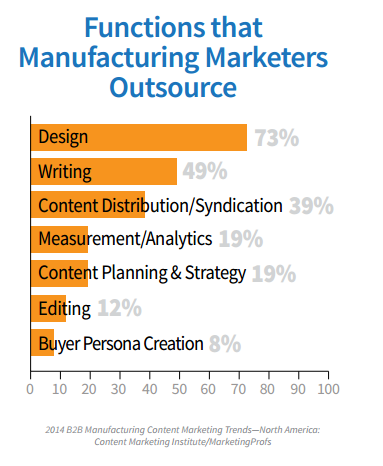
by Fronetics | Oct 30, 2014 | Blog, Marketing, Social Media, Strategy, Supply Chain

The use of third-party logistics providers are on the rise. As many as nine out of ten 3PLs surveyed by Inbound Logistics reported their client base grew by 5 percent this year, continuing the unabated expansion of recent years.
And there’s good reason for it.
In an interesting article on SupplyChain 24/7, Adam Robinson, the marketing guru at Cerasis, lists seven reasons companies should outsource non-core transportation management functions to 3PL providers. Surprisingly, perhaps, many of the same arguments can be applied to companies debating who should be in charge of their content creation.
As the number one reason to outsource, Robinson cites “Time and Money.”
He writes:
“3PL providers are able to reduce the amount of infrastructure investments in equipment, software, facilities and personnel… These 3PLs are like having non-paid employees on your staff and allow shippers to focus resources on areas where they are the expert (i.e. manufacturing, product sales).”
Time and money – or lack thereof – are similarly common issues among companies with respect to social media. In a new Fronetics report on social media use in the supply chain and logistics industries, nearly half of the respondents cited time and budgetary constraints as their top two challenges. Such companies may, as a result, participate only sporadically or not at all.
Since consistency is crucial to online lead generation, anything but a fulltime commitment to the company blog, content curation, and social media outreach is doomed to fail. An outside provider can, just like a 3PL, take these tasks off your hands, allowing you to focus on your core competencies.
Robinson also argues:
“As shippers rely on 3PL partners to provide more strategic oversight, and help catalyze business process change within the organization, the relationship is growing more fluid, and less analytical. Service providers are becoming an extension of the enterprise.”
In short, 3PL providers should not be perceived as outsiders but as partners who know their stuff. They contract with thousands of carriers and know the fastest and most reliable routes to move product from point A to point B.
A marketing company, especially one specialized in content creation for the logistics, transportation and supply chain industries, works the same way, drawing on a wealth of industry knowledge. In essence, you hire experts equipped with the right strategic tools to leverage their market expertise to your advantage.
Finally, Robinson writes visibility of loads gives 3PLs a leg up on the competition:
“Many 3PLs are able to integrate tracking into shipper IT systems, provide integration into ERP and WMS automated notices or even real-time delivery notifications by e-mail.”
Losing track of a shipment equals chaos. 3PL providers are there to ensure it never happens. In the same vein, companies need to track the metrics of their content strategy or risk wasting resources on something that yields no results. They need to know which social media outlets work for their business and what types of content draw traffic to their site. It takes time and resources – and as our survey revealed, both tend to be in short supply.
Your content marketing partner, on the other hand, knows metrics is as important as a shipment is to a 3PL provider.
Outsourcing content creation may be your strategic advantage over your competition.

by Fronetics | Sep 30, 2014 | Blog, Strategy, Talent

Are your sales reps as sold on your leads as you are?
In theory, it seems straight forward: You write engaging blog posts; you spread your unique as well as curated content via appropriate social media channels; you include calls to action; you watch your prospects take the bait; and, finally, you hand off a neat list of qualified leads to sales.
Sales, in turn, swiftly goes to work and the sale is a fact.
The reality is, as most of us know, far more muddled. You may be in the habit of dumping any lead, qualified or not, on sales. Sales, on the other hand, may be busy doing anything but tending to your leads. Hours go by. Hours turn into days. When sales finally do follow up, the lead has moved on.
Here is the bad news: Time kills even the most eager leads.
The 2014 Lead Response Report by InsideSales.com shows an undeniable connection between the time it takes to make contact with a prospect and the likelihood of converting that prospect into a customer. Since most companies will send out an automatic e-mail confirmation to anyone who has filled out an online form, the study looked specifically at the phone response rate, which it argues is a much more effective sales tool.
Consider a few of the findings:
- Fifty percent of buyers choose the vendor that responds first.
- The median first call response time was 3 hours and 18 minutes.
- Only a fraction of companies reply within five minutes.
That last number is important because another InsideSales study on lead response management found the following:
“Making a successful contact with a lead are 100 times greater when a contact attempt occurs within 5 minutes, compared to 30 minutes after the lead was submitted. Similarly, the odds of the lead entering the sales process, or becoming qualified, are 21 times greater when contacted within 5 minutes versus 30 minutes after the lead was submitted.”
If you need further proof that response rate matters, an article in Forbes on inbound marketing sums it up perfectly: “If your goal is to ‘pull your customer toward you’ in order to sell them something, then time is definitely of the essence.”
With these statistics in mind, it is more important than ever to ensure marketing and sales are aligned. Too often poor lead-to-customer conversion can be blamed on a disconnection between the two departments.
Work in partnership to establish a common sales funnel. Spell out who is in charge of each step of the sales process. It doesn’t matter who makes that first call to your qualified lead, but it is important that you know someone will actually pick up the phone with a sense of urgency.
Bear in mind: All your leads need to grow cold is time.

by Fronetics | Sep 30, 2014 | Blog, Strategy, Talent

Are your sales reps as sold on your leads as you are?
In theory, it seems straight forward: You write engaging blog posts; you spread your unique as well as curated content via appropriate social media channels; you include calls to action; you watch your prospects take the bait; and, finally, you hand off a neat list of qualified leads to sales.
Sales, in turn, swiftly goes to work and the sale is a fact.
The reality is, as most of us know, far more muddled. You may be in the habit of dumping any lead, qualified or not, on sales. Sales, on the other hand, may be busy doing anything but tending to your leads. Hours go by. Hours turn into days. When sales finally do follow up, the lead has moved on.
Here is the bad news: Time kills even the most eager leads.
The 2014 Lead Response Report by InsideSales.com shows an undeniable connection between the time it takes to make contact with a prospect and the likelihood of converting that prospect into a customer. Since most companies will send out an automatic e-mail confirmation to anyone who has filled out an online form, the study looked specifically at the phone response rate, which it argues is a much more effective sales tool.
Consider a few of the findings:
- Fifty percent of buyers choose the vendor that responds first.
- The median first call response time was 3 hours and 18 minutes.
- Only a fraction of companies reply within five minutes.
That last number is important because another InsideSales study on lead response management found the following:
“Making a successful contact with a lead are 100 times greater when a contact attempt occurs within 5 minutes, compared to 30 minutes after the lead was submitted. Similarly, the odds of the lead entering the sales process, or becoming qualified, are 21 times greater when contacted within 5 minutes versus 30 minutes after the lead was submitted.”
If you need further proof that response rate matters, an article in Forbes on inbound marketing sums it up perfectly: “If your goal is to ‘pull your customer toward you’ in order to sell them something, then time is definitely of the essence.”
With these statistics in mind, it is more important than ever to ensure marketing and sales are aligned. Too often poor lead-to-customer conversion can be blamed on a disconnection between the two departments.
Work in partnership to establish a common sales funnel. Spell out who is in charge of each step of the sales process. It doesn’t matter who makes that first call to your qualified lead, but it is important that you know someone will actually pick up the phone with a sense of urgency.
Bear in mind: All your leads need to grow cold is time.

by Fronetics | Sep 24, 2014 | Blog, Marketing, Social Media, Supply Chain, Talent
“Practice makes perfect.” This is what we have been told by our parents, our teachers, Malcolm Gladwell, and researchers. And, as pointed out by Fast Company, “There’s even a Macklemore song about it, so that makes it real.”
Here’s the problem – it’s not real. A 2014 study found that practice doesn’t make perfect. Instead, reaching a mastery level of whatever it is that you are trying to reach is dictated by your personality, intelligence, and a number of other factors.
Where does that leave us? For business it reaffirms the adage: “Do what you do best, and outsource the rest.”
During a Small Business Week panel discussion Gene Marke, Inc. columnist and owner of the Marks Group, discussed the importance of strategic partnerships and outsourcing:
“One of the smartest things I’ve been seeing companies do is that they do what they do best and outsource the rest. Companies are now thinking more about partners they can work with to provide the type of technologies, services, and solutions they cannot do or don’t have time to do.”
Dan Leberman, the vice president and general manager of PayPal’s North American online small and medium business unit, expressed similar sentiments:
“It’s all about knowing your company’s core competencies. As a small business, you need to decide what you’ll build and what you’ll give to a partner.”
The supply chain and logistics industries have been slower to adopt social media and inbound marketing than other industries. Reasons for this include: a lack of understanding of the benefits, lack of experience, and both time and budget constraints. In short, inbound marketing and associated activities including content creation and social media management are great examples of what companies within the supply chain and logistics industry should consider outsourcing.
A 2014 study found that 86 percent of manufacturing marketers have adopted content marketing and that the majority (55 percent) of companies look to outsource partners for help.
As shown below, manufacturing marketers outsource a variety of content functions including writing, distribution, design, and editing.

Now that we know practice doesn’t make perfect – play to your company’s strengths and considering outsourcing the rest.

by Fronetics | Sep 17, 2014 | Blog, Marketing, Strategy, Supply Chain

At Fronetics we work with companies within the supply chain and logistics industries to reach their business and marketing goals. We work with our clients to identify and execute strategies that produce results.
As discussed in a previous post, too often I see companies who have invested time and money into developing a B2B inbound marketing strategy and have fallen flat. Reasons include: a lack of strategy and commitment; not targeting the ideal customer; not publishing content consistently; not creating quality content; and being too focused on sales.
Is your current marketing strategy working? Does your website attract and engage? Does your website generate leads? Does your company generate leads via social media?
How many times did you answer “I don’t know,” or “no?” Be honest.
We are offering a free marketing assessment. The assessment includes a discussion focused on your current goals and challenges, an evaluation of the competitive landscape, and actionable strategies to help you grow your business.
Don’t worry, there is no fine print and there are no obligations.






